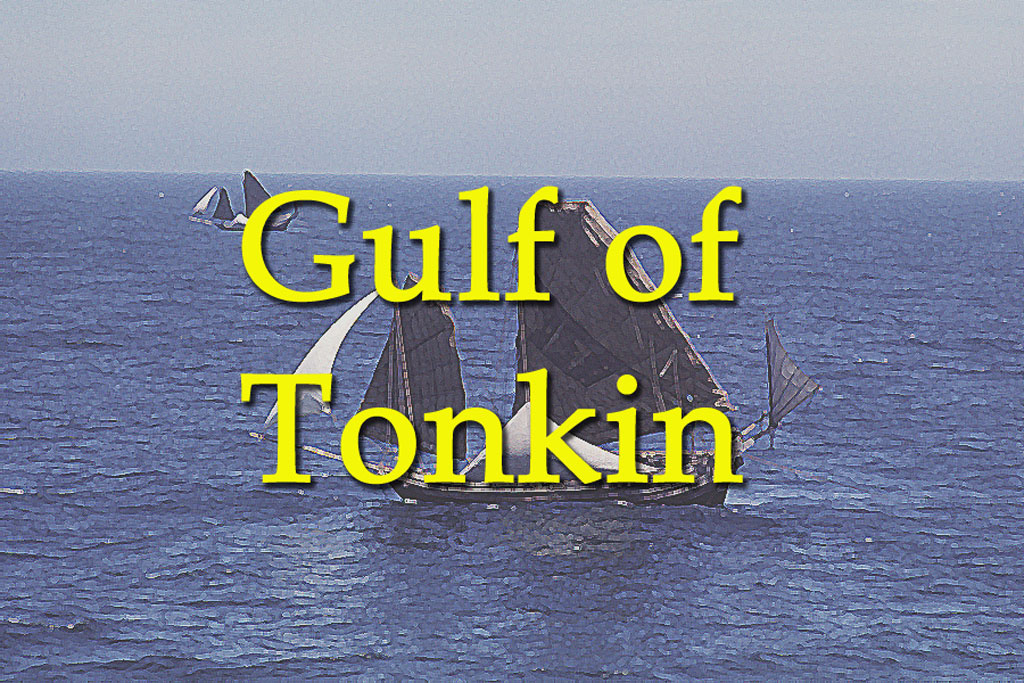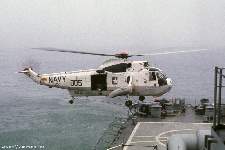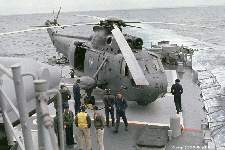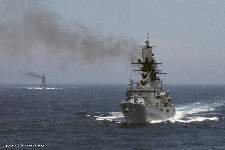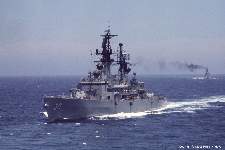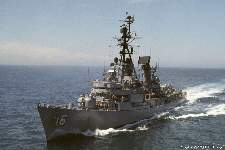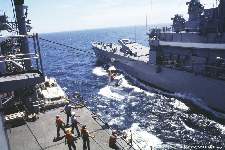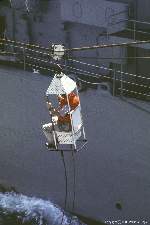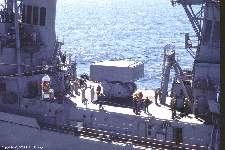An old Navy joke is to reply to the question "What have you been doing lately?" with the answer "I spent the summer sailing on my uncle's yacht." Uncle Sam, that is. The sailors of the Seventh Fleet took it a bit further, and called themselves the "Tonkin Gulf Yacht Club." We spent about a third of our time driving the Admiral's yacht around the gulf. The ship spent all or part of 83 months (6 years 11 months) participating in the Vietnam War.
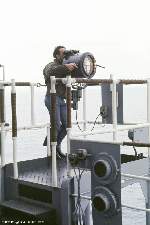
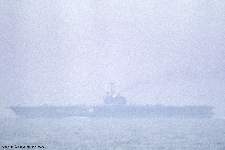
We normally didn't spend much time at Yankee Station, an area in the Gulf about 100 miles off shore. This is where the carriers hung out, providing air cover for bombing raids into the north and support for ground forces in the south. The Okie Boat (call sign "Fireball") did venture there once in a while so the Commander of Seventh Fleet (ComSeventh) could visit the carriers. It was common for ships to communicate with signal lights like the one in the photo. You can see the carrier responding at right.
Admiral Bringle was a "blackshoe" sailor, a line officer or ship driver. When he was ComSeventh we rarely visited Yankee Station. He was followed by Admiral Wiesner, who was an "airdale" or pilot, and he liked to visit the carriers often. When we steamed into the Vietnam area we usually passed through Yankee Station so Admiral Weisner could fly to a carrier and then we proceeded to the gun line near Da Nang or missile station near Vinh in North Vietnam.
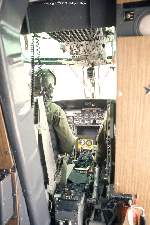
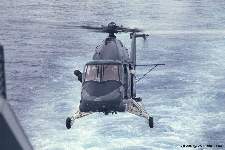
The ship carried a helo detachment for the Admiral. The helo's call sign was Blackbeard One. The photo shows the Kaman SH-2B helicopter making an approach to the helo deck on the fantail. On one occasion Blackbeard One flew me from the ship to Da Nang, Vietnam, and I snapped the photo on the right from the Admiral's seat.
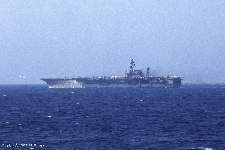
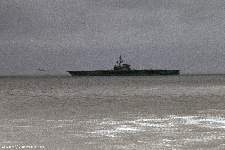
While at Yankee Station the Oklahoma City usually maneuvered to stay out of the way of the carriers which were almost always conducting flight operations. On the left you see the USS Constellation CV-64 launching aircraft. On one occasion we steamed close alongside a carrier and had a front row view of aircraft being launched and landing. Unfortunately I was on watch on the bridge and wasn't able to take photos.
While we operated off Vietnam we participated in frequent personnel and material transfers between ships, usually by helicopter. At left is a picture of a helo from the USS Ranger CV-61. Occasionally we sent our motor whaleboat to another ship. One important regular visit was from the mail helo, call sign Big Mother. The photo below right shows the huge helo squeezed onto our rather small landing area.
A few times we participated in a highline transfer. Such transfers were not unusual - they were a standard part of the Navy's methods for transferring personnel from ship to ship. One day, however, it was the Admiral, ComSeventh, who highlined.
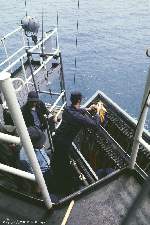
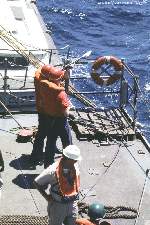
The "skivvy wavers" (signalmen) sent signal flags aloft to initiate the highline transfer. Then the participating ships maneuvered alongside. For these transfers it was common to have a trailing ship on station behind to pick up the person being transferred in case the highline equipment failed. The photos are from two different transfers with the USS Horne DLG-30 and the USS Joseph Strauss DDG-16, but I have put them together to illustrate the whole sequence.
First a shot line was sent to the other ship. They tied the transfer line to it and we hauled it aboard. Unlike UNREPS transfers, which used steel wire and winches, highline transfers always used manila rope. Manila did not stretch and was easier to handle, and that was important because the lines were always pulled by hand.
The transfer line was steadied by a gang of men pulling on it, while crews on both ships hauled on the lines that pulled the bos'uns chair between the ships. The reason for manhandling the lines was to maintain an even strain as the ships rolled and try to keep the chair from swinging wildly. If the lines were fastened to the ships and pulled with winches it would be much harder to control. To understand the problem, place a paper clip in the middle of a length of string and then suddenly pull the string tight. Notice how the clip spins rapidly around the string? We didn't want to do that to someone in the chair. We really didn't want to do it if that someone was the Admiral!
We spent much of our time in Vietnam on missile patrol off North Vietnam. From our station off the city of Vinh our search radars could cover all of northern Indochina, and our Talos missiles could intercept NVN aircraft over a large part of North Vietnam. Sometimes we patrolled off Haiphong, occasionally getting close enough to shore to be able to see buildings.
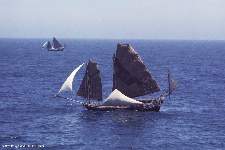
While we were there it was common for North Vietnamese "fishing" boats to accompany us. They reported our activities to shore.
The "spy" boats were pretty easy to distinguish from ordinary fishing boats by the 60 foot whip antennas they carried. Early in the war
these were called WBLTs, or "wiblets" for water-born logistics targets, and the Navy used them for target practice. However, by the time
I was on board they were off limits, so we usually had quite an entourage. These boats tried to maneuver into position ahead of us while
we were engaged in UNREPS to disrupt these operations. They were a minor nuisance.
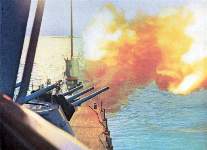
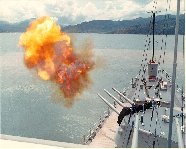
We also served quite a bit of time on the gun line. We used our 6 inch and 5 inch guns to provide artillery support for our troops ashore. We usually patrolled at point Alpha near the DMZ between north and south Vietnam or at point Delta near Da Nang. Here are some Navy photos of the six inch guns firing. *
I had many opportunities to see the guns firing up close while standing bridge watches. At times when the 5 inch guns were trained aft I could look into the ends of the gun barrels less than 20 feet away while we were shooting. It was extremely noisy! I lost my high frequency hearing while standing bridge watches during fire missions. I still have ringing in my ears that started back then.
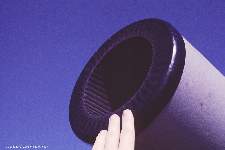
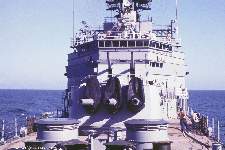
Here is a photo of the end of a 6 inch gun barrel during a lull between fire missions. Notice the flash burns radiating from the rifling grooves, where the fire escaped as the shell was passing out of the barrel.
When we were standing by for fire missions, waiting for a call for support from spotters ashore, we just steamed in triangles around our duty station. While doing this life continued normally, with the crew working topside forward or just running laps for exercise. When not on duty we often spent time topside to take in the rays if the weather was nice. However, we had to be ready to clear the decks in a hurry if a fire mission was called in.
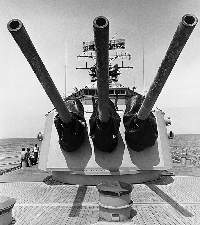
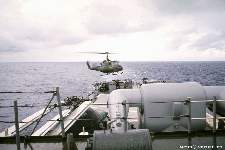
Notice the charged fire hoses on deck. These were ready in case of a "hot gun." When the guns fired they got very hot. If we had a misfire, where the powder charge failed to go off, the projectile inside the barrel might "cook off" and explode if it got too hot. This would destroy the gun and probably the turret. When we had a hot gun the turret was evacuated and a running fire hose was shoved into the barrel and another was trained on the outside to cool things down. It was a pretty tense situation until the gun was cool. The official Navy photo at left shows the blistered paint on the Okie Boat's 6 inch guns after a sustained fire mission in 1972.
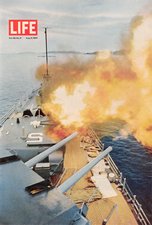
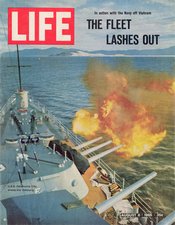
During gunfire operations there was a lot of waiting for "Charley" (the Viet Cong) to give us something to shoot at. Occasionally a Huey would bring a spotter aboard from shore to discuss pending operations and the opportunity for gunfire support. Sometimes the helos would bring war correspondents to film the action. The ship was featured in Life magazine in 1965.
One morning while we were orbiting Point Alpha at the DMZ between North and South Vietnam a helo brought a bunch of war correspondents to the ship to get pictures of the Okie Boat in action. We didn't fire the guns unless we had a target to shoot at, so we all waited for one to come along. After several hours of nothing happening we called the spotters on shore to see if there was anything we could shoot at. They didn't have any targets. After another hour or so we called back and asked them to find a place for us to shoot so the newspapers could get some pictures. They picked a spot in the jungle and we fired a few rounds. After that we had dinner and the reporters left. A few days later there was a big story in Stars and Stripes about a big NVN invasion over the DMZ and a description of one of the biggest actions of the war.
An indirect gunfire mission started when a spotter called in a job. He gave us the target map coordinates and the ships computers calculated the firing solution. Then we fired a spotting round. The spotter observed where it hit and gave us corrections. Then we began "fire for effect," expending whatever rounds were needed to accomplish the mission.
The dense jungles in Vietnam sometimes caused problems for the spotter. On one occasion we fired a 5 inch spotting round, and the spotter answered "Lost, repeat." We fired again with a two gun salvo, and the spotter failed to see it. We repeated using "willie peter" (white phosphorous) which makes a big cloud of white smoke. "Lost, repeat" came back from the spotter. At this point the Captain asked us to check the fire solution, just to be sure we weren't blowing the top off a mountain between us and the target. No, the rounds had plenty of clearance over the hilltops.
The Captain decided to switch to the 6 inch battery, and we fired a round. The spotter didn't see it. So we fired a three gun salvo. Again, the spotter didn't see the explosions or smoke. We fired one more three gun salvo, which also went unobserved. At this point we gave up. The triple canopy jungle was too dense for the effects of twelve rounds to be seen!
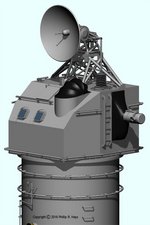
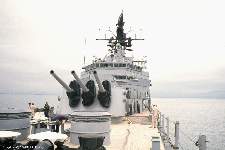
One of my duty stations was Director Officer in the Mk37 fire control director high above the forward superstructure. You can see it the photo at right, high up on the top of the superstructure, the gray box just below the black painted forward radar tower. The view from up there was spectacular, a ring side seat for everything that was going on. I didn't stand watches there for very long and I never got a chance to fire the guns. I got sea sick if the ship pitched or rolled a lot, and I think the Captain took pity on me and reassigned me to duty in CIC (Combat Information Center), on the first platform far below the main deck where the ship rode a bit easier. Too bad - firing the guns would have been fun.
The Director Officer sat in the position covered by the black weather hood. I had a set of binoculars that were trained wherever the guns were aimed, and two triggers mounted just in front of the chair. Behind the two windows sat the elevation and bearing control operators. These men used the fire control radar or the optical range finder to determine distance and bearing to targets. The fire control computers used information from the director to aim the guns.
The Director Officer could fire the guns directly at targets that were in visual sight. The procedure was to squeeze the left trigger twice to ring a bell on the bridge, in the turret or gun mount, and in the gun plot computer room to warn that the guns were about to fire. The third squeeze was on the right hand trigger to cause the gun to fire. Buzz, buzz, bang. The same procedure was followed when the guns were fired indirectly from gun plot below decks. Occasionally in the excitement of the moment someone squeezed the wrong triggers, followed by bang, buzz, buzz. This was very annoying, especially for the bridge watch, because we didn't have time to jam our fingers in our ears.
Direct fire under director control could be very accurate. A good Director Officer could do some amazing work with the guns. Marine First Lieutenant Bob Potter was our best Director Officer. On one trip to a range in the Philippines Bob blew up all the regular targets ashore. Then he turned his attention to a huge house-sized rock with a bulls-eye target painted on it that sat high on the hillside. He pumped rounds into the hill below the rock and rolled it down to the beach. Afterwards the Commanding Officer of the range sent us a nasty note complaining about the damage. The Captain's reply to Bob was "Good shooting Mr. Potter!"
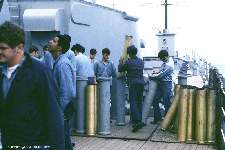
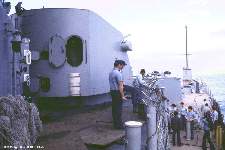
After gun fire missions we had to "police brass" or clean up the spent powder casings lying on the deck. The cases were ejected at the rear of the 6 inch turret and 5 inch gun mount. We didn't have time to deal with them while firing, and you wouldn't want to be on deck close to the guns anyway. The brass powder cases were packed into the powder shipment cans we received them in. They were sent back to the ammunition ships when we did an underway replenishment to restock with ammunition.
I also served as Gunnery Liaison Officer in CIC during gunfire support missions. It was my job to monitor communications between spotters on shore or in light aircraft circling the target area and the ship's gunfire control crew. The CIC watch double checked the target designations and fire control solutions to be sure we were shooting at the correct targets. Occasionally there were muddled communications between the people on shore and the ship, and we had to sort it out.
On one occasion when I was Gunnery Liaison Officer we received an urgent call for indirect fire support from a spotter in a light airplane. He reported that Viet Cong were overrunning a town, and gave us the coordinates. He was calling antipersonnel fire into the center of a pretty large town. We held fire while getting confirmation from I Corps Headquarters in Da Nang. They said to commence firing, so we did. We fired a spotting round but the observer failed to see it. We fired a second spotting round, and again it wasn't observed. At that point we asked the spotter to confirm the coordinates, and he reported a different set - he had reversed north-south and east-west coordinates. We were firing into the wrong town! I learned later that there were several civilian casualties. After all the flap over Lt. Calley and the Mai Lei fiasco we crossed our fingers and hoped the news media didn't pick up the story (they didn't)! It reminded me of a cartoon I saw when I was in college. It depicted an airplane with bombs falling beneath it flying over a village. "Oops" the pilot said, "Well they certainly are hostile now."
Speaking of Mai Lei, we were called in for a gunfire mission near one of the seven villages in the Mei Lei area. The targets were concrete bunkers. We wanted to fire high so the 6" armor piercing projectiles would plunge down on the top surface of the bunkers and have a good chance of penetrating. But the spotter insisted we use low angle fire, shooting directly at the bunkers at a low angle. We didn't think it would work but we fired a few rounds. As we expected, the bullets ricocheted off the sloping sides of the bunkers with no effect. One bullet came down in a rice paddy and skipped across it like a rock. A farmer plowing the paddy with a water buffalo saw the bullet coming at him and ran. The bullet killed the water buffalo, and the farmer ran into a barbed wire fence and was cut up a bit. I later learned that the US government paid for the buffalo and for medical treatment for the farmer. At the time we were really worried that the news media would pick up on the story. We could just see headlines about the Oklahoma City bombarding Mei Lei!
On another occasion we received a call from an airborne spotter for direct fire (target visible from the ship) into some caves along the shore that were suspected of being VC storage sites. When we came into range the Director Officer reported the target was crowded with families fishing along the beach. We reported this to the spotter and asked him to confirm the target. He came back with another target a few miles up the beach. Again, at this target there were people fishing on the beach. The Captain called down to CIC and asked us to use the air search radar to locate the spotter plane. We couldn't see it, but we did see the plane's IFF (Identification Friend or Foe) signal and plotted its location. The plane was sitting on the runway at a nearby air strip! The spotter, who was supposed to fly over the target area and verify that it was safe to fire, was just sitting in the plane on the ground and using the radio to call fire missions. We told him to forget it and left.
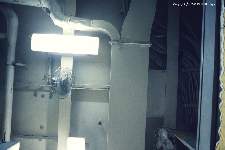
The gun line was mostly boring waiting interspersed with repetitious firing. The worst missions were "harassment and interdiction" (H&I) firing. It was usually done at night, all night long at thirty minute intervals. These were unobserved (no spotter) gunfire to pump bullets into the jungle where the Vietcong "might" be hiding. We fired a lot of rounds into Elephant Valley while sitting in the harbor at Da Nang. It was supposed to keep the VC awake so they would be tired and lower their morale. I don't know if any VC ever heard the explosions, but I certainly noticed. My bunk was just below the main deck about twenty feet from the 5 inch gun barrels, and the gunfire kept me awake all night. The shock wave from the guns was so strong that it caused the paint to flake off the overhead above my bunk! I might go three or four weeks without much sleep. My rear was dragging most of the time and it didn't do much for my morale!
Of course the real reason for expending rounds all night long had nothing to do with the VC. It was done to convert taxpayer dollars into profits for stockholders in the companies who supplied ammunition. It wasn't just the Navy ships stationed all along the coast that wasted ammunition in H&I fire. We could see the army artillery units ashore firing every thirty minutes all night long. Well, like Grace Slick said, war is good business!
We took our only combat casualty one night during H&I fire. A sailor on duty in the 6 inch turret disappeared after he was relieved by the next watch. The ship was rolling in nasty weather, and the turret was trained outboard toward land. It was thought that as he climbed out of the hatch at the rear of the turret he may have slipped and tumbled over the side. In the dark the lookouts would not have seen him go overboard.
When conducting Naval Gunfire Support (NGFS) the ship moved to a station a few miles off the coast and waited for missions to be called in from spotters ashore. While waiting the ship typically steamed back and forth or in a triangle around the station. When a mission was called in the ship moved to a good firing position and opened fire with the spotter calling in corrections. Firing continued for as little as 15 minutes or up to an hour or more. After the mission was complete the ship returned to the waiting station. We often received several NGFS missions each day, sometimes for three to four weeks at a time. We left the station about once a week to refuel, and rendezvoused with ammunition ships about every three days. During periods of heavy gunfire support activity the ship would rearm every day, firing until we ran out of bullets, rushing out to rearm, then returning to resume firing. At night we sometimes fired H&I all night long.
Several times during the war the ship patrolled the North Vietnam coast and bombarded military installations. During these missions the ship occasionally came under fire from NVN coastal batteries. When this happened an artillery duel ensued until the coastal battery was destroyed. NVN guns never hit the OK City. Some of the most intense naval gunfire activity took place during the Battle of Dong Hoi in April 1972. The OK City was attacked by MiG 17 aircraft and torpedo boats while conducting a gunfire duel with NVN shore batteries. The bombs missed the Okie Boat, but the USS Higbee DD-806 was hit. It was the first time since WWII that US Navy ships were attacked from the air. Shrapnel from a near miss did cause minor damage to a wire antenna on the OK City. In May 1972 the USS Oklahoma City CLG-5, USS Providence CLG-6 and USS Newport News CG-148 plus two destroyers conducted a raid against the defenses on the Do Son peninsula at the entrance to Haiphong Harbor. It was the first multiple cruiser gunfire operation since the end of WWII. Other gunfire missions against North Vietnam were conducted during Operation Linebacker in the summer of 1972.

As you can probably tell, time on the gun line was the least enjoyable part of my duty aboard the Okie Boat. We stood one in three watch rotations, which meant that we were on watch 10 to 12 hours a day. In addition, we had our regular jobs to do, as well as eating and sleeping. It was impossible to sleep for more than a few hours at a time, if you could sleep at all. After a few weeks of this the entire crew was exhausted. In this photo I was catching some sun before going back on watch, with a letter from home in my shirt pocket.
For my 195 days in the combat zone during my 27 month tour of duty on the USS Oklahoma City I was awarded the Vietnam Service Medal and authorized to wear four engagement stars.

